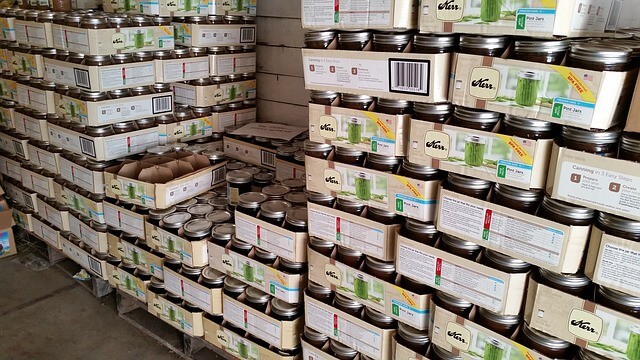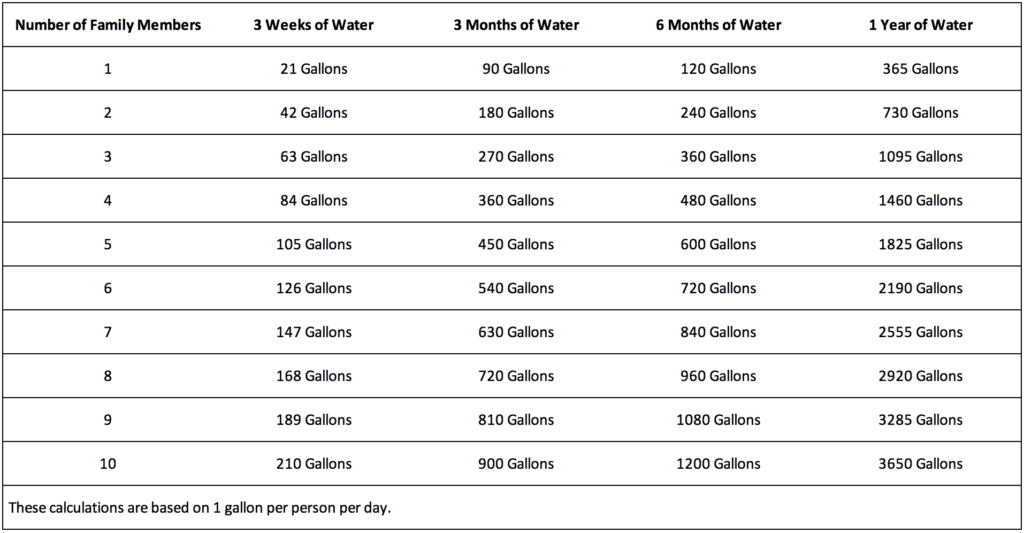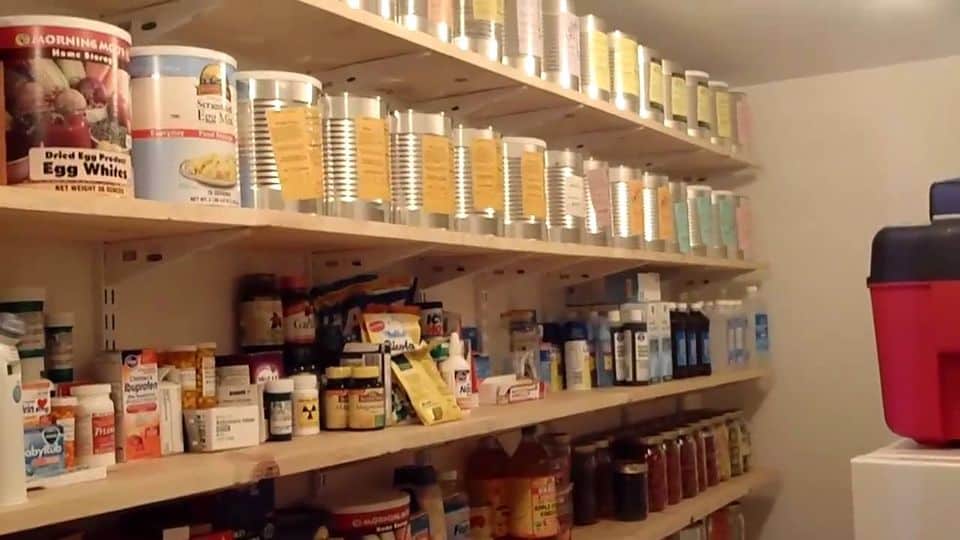Every time I get into a conversation about emergency preparedness, the first question that always comes up is “How much emergency food should I have in case of an emergency?”
The quick answer is, you need anywhere from 3 to 6 months of food stored in your home just in case you experience an emergency such as job loss or a minor natural disaster.
And the honest, more complicated answer is, it depends.
There are many factors to think about when answering this question. The type of emergency for which you are preparing, the amount of time for which you want to prepare, and your financial situation are all important considerations.
If you are strapped for cash, I recommend that you prepare for the worst level of emergency your current financial situation allows.
Let me explain. If your budget is limited, you can prepare in whatever way you can within that budget. If you are financially secure, you will be more able to prepare for a long-term, worst-case scenario, for both your immediate and extended family as well as your friends and/or neighbors. If you fall somewhere in between, you can consider what types of emergencies you may face based on location, and then prepare accordingly.
RELATED:
3 Levels Of Potential Emergency Scenarios
Once you’ve figured out your financial situation and are able to move forward with your emergency food storage plan, consider buying based on the three different levels of potential emergency scenarios.
- Short Term Emergency (up to 30 days)
- Long Term Emergency (3 months or more)
- SHTF – Shit Hits The Fan Emergency (for the foreseeable future)
No matter your situation, we have tips to get you started.
Short Term Emergency Food Recommendations
A short-term emergency is something most of us face at some point in our lives, such as a power outage or a flood from a broken pipeline. Because of this, it is also the most practical type of emergency for which to prepare. This type of disaster will usually be taken care of within a week. Thus, your short-term emergency food storage should include 15 to 30 days’ worth of food and clean water.
This does not include the food and water in your pantry. Rather, this preparedness supply means that you have 15 to 30 full days of food and water for everyone in your household stored away in a place that will not be used unless there is an emergency.
RELATED:
How To Grow Sprouts And Incorporate Them Into Your Emergency Plan
Short Term Food Storage List Ideas
- Rice
- Beans
- Peanut Butter
- Crackers
- Canned meat
- Canned Veggies
- Canned Fruit
- Oatmeal
- Honey
- Granola
- Protein bars
- Seasonings
- Vitamins
- Water

Long Term Emergency Food Recommendations
For long-term emergency preparedness, it is recommended that instead of 15 to 30 days, you store away 3 month’s worth of food and water specifically for the emergency.
Again, this is not the food from your pantry. This is food that you set aside and don’t touch until the emergency hits. There are plenty of food storage options that will last long-term and that you don’t have to worry about spoilage for many years to come.
I address the what, where, and how to store food long term further down in this article.
RELATED:
Common Long Term Food Storage Questions
What should I have in my food storage?
No matter the emergency, these foods should be included in your storage:
- Flour
- Salt
- Sugar, honey
- Baking powder, baking soda
- Yeast
- Lard
- Dehydrated Milk
- Vegetable Oil
- Flint or dent corn
- Cereal, popcorn, crackers, oatmeal
- Dehydrated potatoes
- Canned and dried meat
- Lentils, beans, rice
- Seasonings, bouillon broth cubes
- Textured Vegetable Protein
- Seeds
- Nuts, nut butter
- Dehydrated and canned fruits and vegetables
- Coffee, tea
- Pasta, pasta sauce
What foods last the longest?
The longer our food storage supplies last, the better. As you’ll notice, the above list includes many foods that don’t need to be swapped out often. Starting with a few of these basics can be easy and effective, with little upkeep.
Honey, baking soda, and salt will last your entire life.
Dried beans, rolled oats, white rice and many pasta products can be stored for up to 30 years.
Dehydrated fruits and vegetables have varying shelf lives. While most dehydrated fruits last 5 years, dried carrots actually last 25 years and would be a cost-effective, nutritious option.
Powdered eggs last 7 years, and powdered milk lasts 20, as long as you include moisture absorber in their storage packs.
To spice (or sweeten) up your storage, consider adding Twinkies, which taste delicious for more than 30 years.
Does canned food stay good forever?
No, but there are things you can do to preserve the canned food and increase the shelf-life. For example, if you keep the cans in a cold, dry area, you will extend the shelf life by many months and even sometimes years.
In most cases, keeping canned food past the expiration date will only affect the taste of the product within. That being said, I would only recommend you keeping canned food past the expiration date if you are currently in an emergency situation where you can’t make it to the store.
Otherwise, consider the many different types of rolling racks that allow you to rotate through your cans from oldest to newest. This helps you to always have the newest product in the back and the oldest in the front to consume first.
Please be careful with this recommendation. If the can is damaged at all, please throw it away. It’s not worth the risk of horrible sickness just so you can say you have food storage. Always rotate through your cans as you use them so that you never have to deal with expiration dates until you’re actually in an emergency situation.
Where should I keep my emergency food?
This question depends heavily on what type of space you have available to you.
If the space available to you is a closet or pantry, this is a great option. Although it may be small, it is functional for a 30 day supply.
If you have more space in your home, the basement is a popular choice. Installing a dehumidifier as well as putting food storage on pellets would make the basement a great choice. Both of these could prevent humidity and water damage from ruining your storage.
If a garage is currently where you have space, this is an option. However, garages can become humid, and temperatures fluctuate heavily. If you live in a location with mild temperatures (below 75 degrees) and low humidity, this could be a viable option with a ton of space.
A root cellar is most ideal for a long-term supply for food storage. Although this isn’t an option for many, if it is for you, take advantage of both the space and temperature regulation of a root cellar.
So many people give me the excuse that they can’t buy food storage until they have a home with enough room. Trust me. You can be creative and find ways to store your food no matter the size of your current living situation.
Don’t believe me? Just check out Pinterest for some amazing ideas.
Is it illegal to stockpile food?
For the most part, it is not illegal to stockpile food. There are some cities that don’t allow it but make sure and check your local law before buying too much. Also, be aware of what “too much” food is when it comes to that city. You still might be able to store up to 3 months’ worth without any problem at all.
How much water should I store for an emergency?
You can only survive without water for three days, making it the most important commodity to store. The basic recommendation is to store one gallon of water per day per person.
I’ve broken this down for easier understanding in the chart below:

As a basic rule, the more water stored the better. Consider buying cases of bottled water first, then 5-gallon jugs, then 15-gallon water drums, then 55-gallon water drums. Also, consider having a few effective water purifiers on hand.
RELATED:
How long does bottled water last?
It all really depends on what type of bottle it’s in and where it is stored. For best results, you’ll want to make sure the water is stored in a quality, food-grade bottle or container. This water should be stored in a cool, dry, and dark area.
If the water bottles are clear and they are exposed to sunlight, there is a possibility that they could grow algae.
You also want to make sure the bottles or containers are not stored directly on cement or near any chemicals. The plastic in the bottles can absorb harmful chemicals that can get in the water and make it unsafe to drink.
SHTF Term (Shit Hits the Fan) Emergency Food Recommendations
It is common for people to think that we will all be taken care of by our local or federal
government during a natural disaster or financial downturn. This would be ideal, and in some cases, it might even be true. Still, there are no governmental guarantees. The best thing we can do for ourselves and those around us is to be responsibly prepared for an SHTF disaster.
RELATED:
Example SHTF Scenarios:
- An outbreak where we are asked to stay in our homes for a long period of time until the sickness is contained or vaccinated.
- A large earthquake on a major fault line–the New Madrid Fault, the San Andres Fault, or the Wasatch Fault. If this were to happen, the damage could be devastating for months.
- An EMP, or Electro-Magnetic Pulse. This could come from a solar flare from the sun. This scenario has the potential to (fully or partially) shut down the power grid, which would put us technologically back 200 years. This means no power, which means no running water, which means no flushing toilets, which could mean deadly sicknesses.
- An invasion, terrorist attacks, or war fought in our own backyard. Although we hope for the best, we must consider this as a potential reality.
When it comes to these dire situations, the more prepared, the better. If you have the financial wherewithal to save and store one year’s worth of food storage, you should. And if you have already done this but can store more for loved ones around you, you should.

